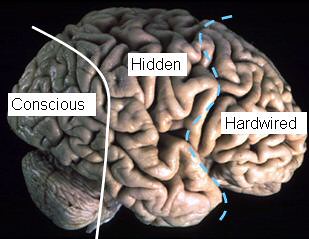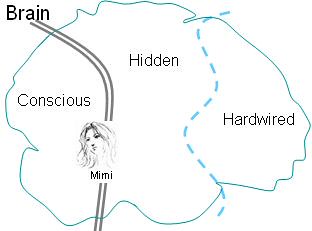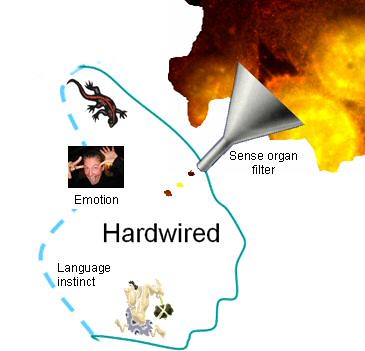Thursday, April 07, 2005
How the brain works
"The human brain is the most complicated material object in the known universe. It weighs about three pounds. If the cortex were unfolded (it's gnarly), it would be the size of a table napkin. It contains 30 billion neurons and a billion synapses (connections)." Gerard Edelman in Wider Than the Sky

Here's a model of how the human brain works. It's not to scale; it's not scientific; I made it up. Nonetheless, let's see what we can learn from it.

For our purposes, we'll assume the brain has three separate areas. The conscious brain is what you're well aware of. The hidden brain contains stuff you've learned but forgotten. The hardwired brain is what your DNA formed.

The fireball at top-right represents reality. Drawn to scale, it would more than fill the building you are in. You see a teeny-tiny shadow of the reality that bombards your eyes, ears, nose, and touch.
The hardwired brain filters this maelstrom of waves and particles, letting less than one in a million register on our consciousness. It chops reality down to a comprehendible size.
Most of the activity of the hardwired brain is automatic. It reads human emotions. It may sense anger and trigger flight before our conscious brain registers anything. One fellow calls it the "First Brain." In a book of the same name, he claims "You got to be believed to be heard," meaning that if you don't pass muster with the hardwired brain, you will never penetrate the conscious brain. It also runs functions like breathing, keeps the heart pounding, and is currently putting me to sleep.
You're not aware of what's going on behind the firewall that divides the conscious and unconscious minds.
Evolution is not a steady uphill climb. Rather, it's two steps forward and one step back. It builds on useful mistakes to kludge together "breakthroughs" which it slaps on top of the old machinery. Hence, the brain is a set of layers, the earliest of which pre-date humanity. Thus the metaphor of the "lizard brain," as the hardwired brain is sometimes called.

Now we're entering slightly more familiar territory. The hidden brain contains everything you've learned but forgotten. Most of this is stored patterns. We kid ourselves that we think logically, that the brain is a bio-computer loaded up with banks of if-the-else decision chips. It ain't so.
The stream of sensory input that remained after the hardwired brain processed it is now fed through more neural processes, some of which relate to the stored patterns in memory. The boundary between the hardwired and hidden brains is porous, for they interact with one another to pare things down to reasonable size and connections to what we already know.
Memories aren't actually stored as memories. Rather, they are built on the fly -- recreated when called for. No one knows what the atomic particles of memories are like.
A lot of our thinking takes place behind the curtain in the hidden brain. When faced with a complex situation, I'll often delegate it to the "boys in the back room," i.e. my hidden brain. They seem to work best at night, while I am asleep. In the morning, the usually will have presented me with a solution.

We've arrived at the part of the brain we are aware of: the conscious brain. This is what's got your attention right now. It's focusing on things that interest you or that are darting around. It can access memories. This is where your picture of the world is formed. Consciousness is your User Interface to your environment. My computer's user interface is a simplified represntation that keeps me from having to deal with the intricacies of machine language, rotating disks, and spnning electrons. Similarly, the UI of consciousness gives me a picture I can deal with.
I'm going to call this voice Mimi (Me, me. Get it?). Cognitive neuroscientist Michael Gazzaniga
calls Mimi "the interpreter." Psychologist Robert Ornstein says Mimi is continually writing our internal resume. Mimi is also our Boswell, interpreting our past and writing our autobiography.
Mimi is a tricky little devil. She convinces you that you're watching the passing parade of life as it happens. In reality, she can't release a story to the conscious brain until the hardwired and hidden brains have done their job. The conscious brain is a TiVo that is always a little behind.
Mimi's narrative reinforces two major beliefs: (a) The world makes sense, and (b) you are in control. Take away Mimi and there's no "you" there. Mimi's creating your identity.
Don't take any crap off Mimi. She will listen if you question her, although you will have to be persistent.
Keep Mimi informed of what's important to you.

Here's a model of how the human brain works. It's not to scale; it's not scientific; I made it up. Nonetheless, let's see what we can learn from it.

For our purposes, we'll assume the brain has three separate areas. The conscious brain is what you're well aware of. The hidden brain contains stuff you've learned but forgotten. The hardwired brain is what your DNA formed.

The fireball at top-right represents reality. Drawn to scale, it would more than fill the building you are in. You see a teeny-tiny shadow of the reality that bombards your eyes, ears, nose, and touch.
The eyes send at least ten million bits to the brain every second. The skin sends a million bits a second, the ear one hundred thousand, our smell sensors a further one hundred thousand bits a second, our taste buds perhaps a thousand bits a second. All in all, over eleven million bits a second from the world to our sensory mechanisms.
Tor Norretranders: The User Illusion
The hardwired brain filters this maelstrom of waves and particles, letting less than one in a million register on our consciousness. It chops reality down to a comprehendible size.
Most of the activity of the hardwired brain is automatic. It reads human emotions. It may sense anger and trigger flight before our conscious brain registers anything. One fellow calls it the "First Brain." In a book of the same name, he claims "You got to be believed to be heard," meaning that if you don't pass muster with the hardwired brain, you will never penetrate the conscious brain. It also runs functions like breathing, keeps the heart pounding, and is currently putting me to sleep.
You're not aware of what's going on behind the firewall that divides the conscious and unconscious minds.
Evolution is not a steady uphill climb. Rather, it's two steps forward and one step back. It builds on useful mistakes to kludge together "breakthroughs" which it slaps on top of the old machinery. Hence, the brain is a set of layers, the earliest of which pre-date humanity. Thus the metaphor of the "lizard brain," as the hardwired brain is sometimes called.

Now we're entering slightly more familiar territory. The hidden brain contains everything you've learned but forgotten. Most of this is stored patterns. We kid ourselves that we think logically, that the brain is a bio-computer loaded up with banks of if-the-else decision chips. It ain't so.
The stream of sensory input that remained after the hardwired brain processed it is now fed through more neural processes, some of which relate to the stored patterns in memory. The boundary between the hardwired and hidden brains is porous, for they interact with one another to pare things down to reasonable size and connections to what we already know.
Memories aren't actually stored as memories. Rather, they are built on the fly -- recreated when called for. No one knows what the atomic particles of memories are like.
A lot of our thinking takes place behind the curtain in the hidden brain. When faced with a complex situation, I'll often delegate it to the "boys in the back room," i.e. my hidden brain. They seem to work best at night, while I am asleep. In the morning, the usually will have presented me with a solution.

We've arrived at the part of the brain we are aware of: the conscious brain. This is what's got your attention right now. It's focusing on things that interest you or that are darting around. It can access memories. This is where your picture of the world is formed. Consciousness is your User Interface to your environment. My computer's user interface is a simplified represntation that keeps me from having to deal with the intricacies of machine language, rotating disks, and spnning electrons. Similarly, the UI of consciousness gives me a picture I can deal with.
One extraordinary phenomenal feature of conscious experience is that normally it is all of a piece--it is unitary. Any experienced conscious moment simultaneously includes sensory intput, consequences of motor activity, imagery, emotions, fleeting memories, bodily sensations, and a peripheral fringe. In any ordinary circumstances it does not consist of "just this pencil with which I am writing," nor can I reduce it to that. Yet, at the same time, one unitary scene flows and transforms itself into another complex but also unitary scene. (Edelman)Listen to yourself think. Hear that inner voice? It's always rambling on, presenting us with truisms, fantasy, lascivious thoughts, attaboys, and shouldas. The voice spins a narrative which becomes our interpretation of the world. It's more than the distraction of "the drunken moneys" who are always hopping around in there.
I'm going to call this voice Mimi (Me, me. Get it?). Cognitive neuroscientist Michael Gazzaniga
calls Mimi "the interpreter." Psychologist Robert Ornstein says Mimi is continually writing our internal resume. Mimi is also our Boswell, interpreting our past and writing our autobiography.
Mimi is a tricky little devil. She convinces you that you're watching the passing parade of life as it happens. In reality, she can't release a story to the conscious brain until the hardwired and hidden brains have done their job. The conscious brain is a TiVo that is always a little behind.
Mimi's narrative reinforces two major beliefs: (a) The world makes sense, and (b) you are in control. Take away Mimi and there's no "you" there. Mimi's creating your identity.
What's in it for me?
Listen to Mimi. Become aware of what's she's telling you.Don't take any crap off Mimi. She will listen if you question her, although you will have to be persistent.
Keep Mimi informed of what's important to you.
